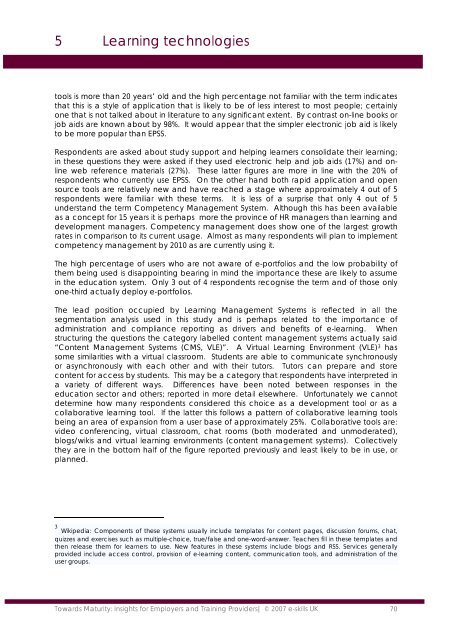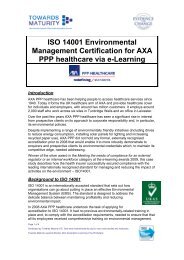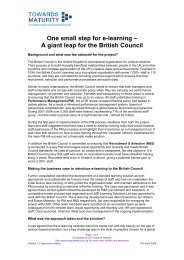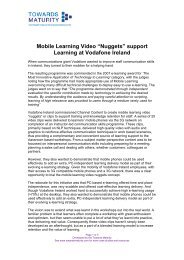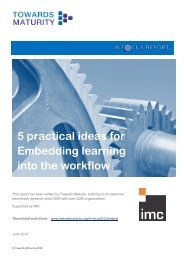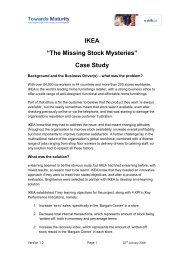Towards Maturity
Towards Maturity
Towards Maturity
Create successful ePaper yourself
Turn your PDF publications into a flip-book with our unique Google optimized e-Paper software.
5 Learning technologies<br />
tools is more than 20 years’ old and the high percentage not familiar with the term indicates<br />
that this is a style of application that is likely to be of less interest to most people; certainly<br />
one that is not talked about in literature to any significant extent. By contrast on-line books or<br />
job aids are known about by 98%. It would appear that the simpler electronic job aid is likely<br />
to be more popular than EPSS.<br />
Respondents are asked about study support and helping learners consolidate their learning;<br />
in these questions they were asked if they used electronic help and job aids (17%) and online<br />
web reference materials (27%). These latter figures are more in line with the 20% of<br />
respondents who currently use EPSS. On the other hand both rapid application and open<br />
source tools are relatively new and have reached a stage where approximately 4 out of 5<br />
respondents were familiar with these terms. It is less of a surprise that only 4 out of 5<br />
understand the term Competency Management System. Although this has been available<br />
as a concept for 15 years it is perhaps more the province of HR managers than learning and<br />
development managers. Competency management does show one of the largest growth<br />
rates in comparison to its current usage. Almost as many respondents will plan to implement<br />
competency management by 2010 as are currently using it.<br />
The high percentage of users who are not aware of e-portfolios and the low probability of<br />
them being used is disappointing bearing in mind the importance these are likely to assume<br />
in the education system. Only 3 out of 4 respondents recognise the term and of those only<br />
one-third actually deploy e-portfolios.<br />
The lead position occupied by Learning Management Systems is reflected in all the<br />
segmentation analysis used in this study and is perhaps related to the importance of<br />
administration and compliance reporting as drivers and benefits of e-learning. When<br />
structuring the questions the category labelled content management systems actually said<br />
“Content Management Systems (CMS, VLE)”. A Virtual Learning Environment (VLE) 3 has<br />
some similarities with a virtual classroom. Students are able to communicate synchronously<br />
or asynchronously with each other and with their tutors. Tutors can prepare and store<br />
content for access by students. This may be a category that respondents have interpreted in<br />
a variety of different ways. Differences have been noted between responses in the<br />
education sector and others; reported in more detail elsewhere. Unfortunately we cannot<br />
determine how many respondents considered this choice as a development tool or as a<br />
collaborative learning tool. If the latter this follows a pattern of collaborative learning tools<br />
being an area of expansion from a user base of approximately 25%. Collaborative tools are:<br />
video conferencing, virtual classroom, chat rooms (both moderated and unmoderated),<br />
blogs/wikis and virtual learning environments (content management systems). Collectively<br />
they are in the bottom half of the figure reported previously and least likely to be in use, or<br />
planned.<br />
3 Wikipedia: Components of these systems usually include templates for content pages, discussion forums, chat,<br />
quizzes and exercises such as multiple-choice, true/false and one-word-answer. Teachers fill in these templates and<br />
then release them for learners to use. New features in these systems include blogs and RSS. Services generally<br />
provided include access control, provision of e-learning content, communication tools, and administration of the<br />
user groups.<br />
<strong>Towards</strong> <strong>Maturity</strong>: Insights for Employers and Training Providers| © 2007 e-skills UK 70


